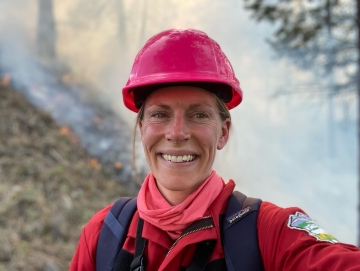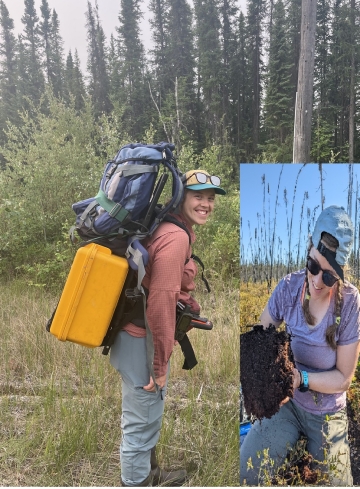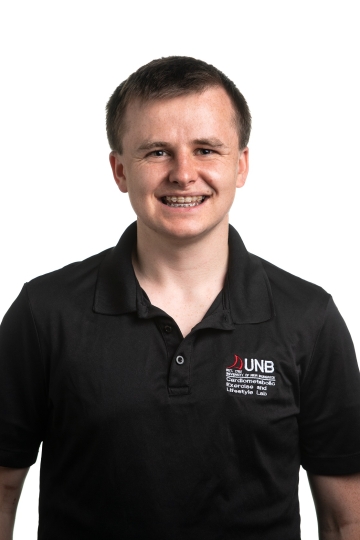Megan Katz
Prosthetic Technician
Institut de readaptation Gingras Lindsay de Montreal
Learn About My Career
Megan is a prosthetic technician who makes and repairs artificial limbs.
I was born/grew up in: Toronto, Ontario
I now live in: Montreal, Quebec
I completed my training/education at: I completed the Prosthetic-Orthotic Technician Program at George Brown College in Toronto, Ontario. I also completed a Bachelor of Fine Arts at the Nova Scotia College of Art and Design University, Halifax, Nova Scotia.
Every day at work is a little different. Most often, it includes building new artificial limbs or prosthetics (arms or legs). On other days, my time is spend adjusting or repairing used ones. I use a variety of materials to create or repair artificial limbs. Some of the more common materials are wood, plaster, metal, leather, fiberglass and glue. I also use some less common materials such as carbon fibre. This material makes a very strong and lightweight prosthetic. I also use special plastics known thermoformable plastics. These plastics can be heated to make molds or shapes. I work in a woodshop-style workshop.
Prosthetic technicians work with a prosthetist to assess the individual needs of each patient. We do not generally see the patients themselves. Technicians often assist the prosthetist during a fitting. Fitting is when the patient tries on their limb. Changes might need to be made to their device to ensure the best fit while the person waits. If it requires major changes, they may come back another time to pick it up.
Technicians can plan their time according to what needs to be completed that day or week. This can include filling casts of the patient's residual limb with plaster. Another task might be making a trial socket out of clear plastic heated in an infrared oven. The socket is then molded around a cast with suction. Sometimes I will make a final socket out of fibers saturated in resin around a cast.
Something else I do is to change parts in mechanical knees, feet, adaptors and connectors. Yes, it's kind of like Lego! Each person's anatomy and lifestyle are different. No two prosthetic devices are exactly alike. That leaves room for creative problem solving. The work requires a good eye for detail, manual dexterity, and the ability to multitask. Often there will be a few projects on the go at the same time. In the end, the devices are made to a high standard to ensure the safety of the patient.
In this job, it's important to understand the materials and chemicals you're working with. It is also important to know how the patient will use the device. This includes the relationship between the prosthetic devices and the forces put on it by the patient. This can help the technician understand why something might not be working the way it should. It will also help them to make a better limb the next time.
I didn't know that this job existed when I was in high school! I completed a Bachelor of Fine Arts in Jewelry and Metalsmithing. When I was near the end of my degree, someone mentioned that there were people who make prosthetic limbs. They saw how the relationship of body and object inspired my art practice. I decided to apply for the two-year degree program at George Brown College.
It was challenging to go back to school, but I enjoyed that everything we learned had a practical application. The field of prosthetics and orthotics is very small and specific. When I graduated the only job available was in Newfoundland. I took the plunge and completed a two-year internship. Then I had to take exams to become a registered prosthetic technician with Orthotics Prosthetics Canada.
Prosthetics is an interesting intersection in health care, the use of technology and craft. I like to take pride in my craftsmanship. I especially love when a patient wants a unique design feature. It's fun to work alongside clinicians and other technicians to share tips and tricks. There are always technological advances. These translate into new materials and components to play with. Applying traditional techniques is still very important. There is often an element of the unexpected in this work. For example, someone may arrive with a "Frankenstein" home alteration or with a 125 year old prosthetic limb family heirloom!
This career is very fulfilling. I get to see someone make use of something I’ve made to help in their daily life.
I enjoy maintaining meaningful friendships, making great food, sending postcards, swing dancing, biking and trying to grow vegetables on my balcony.
School provides a great base of knowledge but you will learn so much through experience. Don't be too shy to ask questions. Try new things and share what you've found. Spend time researching the field but more importantly visit the school. Don't be afraid to talk to the technicians to see if this career is the right fit for you.
What I do at work
Every day at work is a little different. Most often, it includes building new artificial limbs or prosthetics (arms or legs). On other days, my time is spend adjusting or repairing used ones. I use a variety of materials to create or repair artificial limbs. Some of the more common materials are wood, plaster, metal, leather, fiberglass and glue. I also use some less common materials such as carbon fibre. This material makes a very strong and lightweight prosthetic. I also use special plastics known thermoformable plastics. These plastics can be heated to make molds or shapes. I work in a woodshop-style workshop.
Prosthetic technicians work with a prosthetist to assess the individual needs of each patient. We do not generally see the patients themselves. Technicians often assist the prosthetist during a fitting. Fitting is when the patient tries on their limb. Changes might need to be made to their device to ensure the best fit while the person waits. If it requires major changes, they may come back another time to pick it up.
Technicians can plan their time according to what needs to be completed that day or week. This can include filling casts of the patient's residual limb with plaster. Another task might be making a trial socket out of clear plastic heated in an infrared oven. The socket is then molded around a cast with suction. Sometimes I will make a final socket out of fibers saturated in resin around a cast.
Something else I do is to change parts in mechanical knees, feet, adaptors and connectors. Yes, it's kind of like Lego! Each person's anatomy and lifestyle are different. No two prosthetic devices are exactly alike. That leaves room for creative problem solving. The work requires a good eye for detail, manual dexterity, and the ability to multitask. Often there will be a few projects on the go at the same time. In the end, the devices are made to a high standard to ensure the safety of the patient.
In this job, it's important to understand the materials and chemicals you're working with. It is also important to know how the patient will use the device. This includes the relationship between the prosthetic devices and the forces put on it by the patient. This can help the technician understand why something might not be working the way it should. It will also help them to make a better limb the next time.
My career path is
I didn't know that this job existed when I was in high school! I completed a Bachelor of Fine Arts in Jewelry and Metalsmithing. When I was near the end of my degree, someone mentioned that there were people who make prosthetic limbs. They saw how the relationship of body and object inspired my art practice. I decided to apply for the two-year degree program at George Brown College.
It was challenging to go back to school, but I enjoyed that everything we learned had a practical application. The field of prosthetics and orthotics is very small and specific. When I graduated the only job available was in Newfoundland. I took the plunge and completed a two-year internship. Then I had to take exams to become a registered prosthetic technician with Orthotics Prosthetics Canada.
I am motivated by
Prosthetics is an interesting intersection in health care, the use of technology and craft. I like to take pride in my craftsmanship. I especially love when a patient wants a unique design feature. It's fun to work alongside clinicians and other technicians to share tips and tricks. There are always technological advances. These translate into new materials and components to play with. Applying traditional techniques is still very important. There is often an element of the unexpected in this work. For example, someone may arrive with a "Frankenstein" home alteration or with a 125 year old prosthetic limb family heirloom!
How I affect peoples’ lives
This career is very fulfilling. I get to see someone make use of something I’ve made to help in their daily life.
Outside of work I
I enjoy maintaining meaningful friendships, making great food, sending postcards, swing dancing, biking and trying to grow vegetables on my balcony.
My advice to others
School provides a great base of knowledge but you will learn so much through experience. Don't be too shy to ask questions. Try new things and share what you've found. Spend time researching the field but more importantly visit the school. Don't be afraid to talk to the technicians to see if this career is the right fit for you.
When I was a student I enjoyed:
- Art
- Drama
- Foreign Languages
- Geography
- History
- Literature and Language Arts
- Science
- Foods & Nutrition
- Music
- Industrial Arts
When I was a student, I would describe myself as someone who:
- Brought people together
- Liked helping people
- Organized activities for my friends
- Enjoyed working with my hands
- Was motivated by success
- Liked being given specific instructions
- Engaged in volunteer activities
- Was really creative
- Liked being given free range to explore my ideas
- Felt great satisfaction in getting good grades
- Wasn't sure what I wanted to do
- Liked to design or build things
- Liked to take things apart to see how they worked
- Learned best "by doing"
Related Topics
Explore More Career Profiles
-
Brianna Lummerding
Career Profiles
Agronomic Innovation Manager
I look after all things related to soil management for a group of retailers. -
Li Tan (he/him)
Career Profiles
Molecular Lead
I coordinate the day-to-day operations in the DNA Extraction Lab. -
Tyler Morhart (video)
Career Profiles
Scientist, Beamline Responsible - SyLMAND
I am responsible for the SyLMAND beamline at the Canadian Light Source synchrotron facility. -
Li Tan (Video)
Career Profiles
Molecular Lead
I coordinate the day-to-day operations in the DNA Extraction Lab. -

Rashell Featherstone (she/her)
Career Profiles
Senior Program Associate
I coordinate projects for the development of new products at STEMCELL. -

Kira Hoffman (she/her)
Career Profiles
Postdoctoral Researcher/Fire Ecologist
I am a researcher at both a university and a not-for profit organization where I am gaining experience to become a senior researcher. -
Zoë Ehlert (Video)
Career Profiles
Manager, Marker Assisted Breeding
I lead a team that develops canola crops by breeding plants with traits we are looking for. -
Zoë Ehlert
Career Profiles
Manager, Marker Assisted Breeding
I lead a team that develops canola crops by breeding plants with traits we are looking for. -
Jennifer Baltzer (she/her)
Career Profiles
Professor and Canada Research Chair in Forests and Global Change
I work at a university, teaching students and conducting research on the impact of climate change on forests in Canada and around the world. -

Caitlyn Lyons (she/her)
Career Profiles
Ph.D. Candidate
I am working towards my PhD and studying the forests in the Northwest Territories. -

Joann Whalen
Career Profiles
Professor at the Faculty of Agricultural and Environmental Sciences,
I teach advanced courses on how to manage soils to produce healthy, nutritious food and maintain healthy ecosystem functions.

